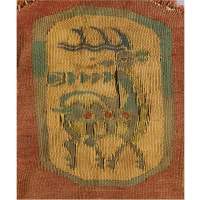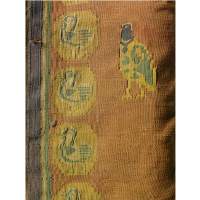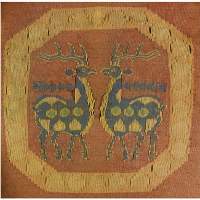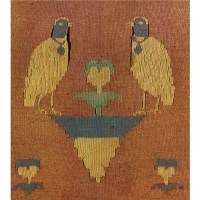 |
 Gazelle Motif |
 Birds Motif |
 |
 Pair of Gazelles Motif |
 Pair of Birds Motif |
A rare Sogdian split tapestry (kilim) coat with animal motifs, Central Asia, 9th/10th Century. Photos: Sotheby's.
On red ground with yellow and green animal motifs, comprising gazelles at the shoulders within a circular pattern, yellow disks along the sleeves, the length of the coat at the lapel with border of small birds and four larger dark-headed birds, on the back two large gazelles confronting each other within a medallion, two birds facing each other set upon a pyramid and carnation, two smaller birds surrounding a stylised tree and further border of small birds in roundels at the bottom of the coat, with silk lining - 112.7 by 123cm. max. Est. 100,000—120,000 GBP. Lot Sold 802,850 GBP
NOTE:
Sogdian civilisation has been traced back to the 6th century BC but it was not
until the 7th century AD that the Sogdians achieved semi-independent
status. With this came economic prosperity and stability leading to
lavish architectural and artistic patronage with palaces decorated with
opulent wall paintings.
The themes of their frescoes rely heavily on religious motifs, and occasionally literary themes focusing on the Aryan epics.
Zoroastrian, Nestorian Christian, Manichean, Hindu and Buddhist motifs were depicted in styles borrowed from a variety of sources
reflecting their extensive trading contacts: Sasanian, Central Asian, Far Eastern and Indian.
The Sogdians position on the trade routes of the Silk Road, which Sogdian merchants controlled from the 1st century AD onwards playing a major
role negotiating between China and Central Asia, continued to be vital to their resources and holdings well into the 10th century.
A recurring motif in pictorial records of Sogdian clothing is the large medallion enclosing smaller "pearls",
as evinced in the present example.
This design can also be traced in figural representations in frescoes in western China from the 6th/7th centuries, see Cécile Beurdeley,
Sur les Routes de la Soie, Fribourg, 1985, pp.116-117, no.116-118.
The frescoes at the palace of Penjikent (extensively published in A.M.Beleniziki,
Kunst der Sogden, Leipzig, 1980, pp.41-140) clearly illustrate the utilization of the circular theme.
Sogdian art is quite close in style to that of the Sasanians.
It was the bird motif seen here that was the most commonly adopted design.
Quinte-Curce, a first-century AD Roman historian, described the robes of the Persian satraps as comprising a design of two birds threatening
each other with their beaks (Beurdeley, Sur les Routes de la Soie, p.162).
An example of this was found in tomb 134 in Turfan in 1969 together with a stele dated to 662 and is currently held by the Museum in Xinjiang, China.
Although earlier in date, this is the closest published example to this coat.
The majority of Sogdian textiles that have been found, such as those in the Hermitage Museum, St. Petersburg, and the Cleveland Museum of Art,
are produced using silk.
This adds to the rarity of the tunic here which is made of wool.
The silk examples in the Hermitage have the same design with the roundels enclosing further discs.
These medallions would encircle motifs of birds, wild boars, double-sided axes, and other animals.
A Carbon 14 test has confirmed the 9th-10th century dating.
